Qatar Islamic Bank Bundle
Who Really Controls Qatar Islamic Bank?
Unraveling the ownership of a financial powerhouse like Qatar Islamic Bank (QIB) is key to understanding its future. Knowing Qatar Islamic Bank SWOT Analysis is important to know the company's position. This exploration goes beyond surface-level details, offering a comprehensive look at who owns QIB and the implications for its strategic direction. Discover the key players shaping the trajectory of one of Qatar's leading financial institutions.
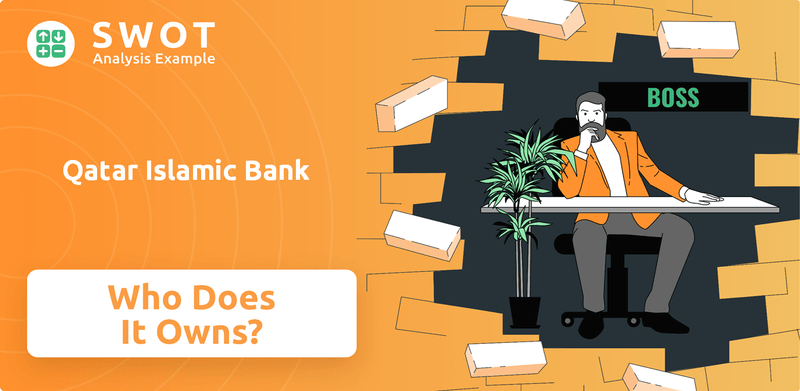
Understanding the intricacies of QIB ownership is crucial for anyone interested in Qatar's financial landscape. This analysis will delve into the evolution of QIB ownership, from its inception to the present day, examining the influence of major shareholders and the impact of public shareholding. We'll explore questions like: Who is the major shareholder of Qatar Islamic Bank? What are the stakes of QIB bank owners? This deep dive will provide valuable insights into the governance and strategic vision of this important player in Islamic banking Qatar.
Who Founded Qatar Islamic Bank?
Qatar Islamic Bank (QIB) was established in 1982, marking a significant milestone in the evolution of Islamic finance. The formation of QIB was spearheaded by a collective of prominent Qatari individuals and institutions. Their shared vision was to establish a financial institution that strictly adhered to Islamic Sharia principles, catering to the growing demand for Sharia-compliant financial services in Qatar.
The initial ownership structure of Qatar Islamic Bank involved key figures from the Qatari business and financial community, alongside significant contributions from government-related entities. This collaborative approach was crucial in ensuring the bank's adherence to its Islamic mandate and its role in the nation's economic development. The early shareholders included prominent Qatari families and institutions. The bank's founders were driven by a shared commitment to the bank's core principles rather than individual dominance.
The specific equity splits and individual shareholding percentages at the company's inception are not publicly detailed for all founders. However, the foundational ownership was a collective effort. The early backers saw the potential in Islamic finance. Discussions around early agreements, such as vesting schedules or buy-sell clauses, are not commonly disclosed for institutions of this nature from that period.
The founders aimed to create a financial institution strictly adhering to Islamic Sharia principles. This vision was a response to the growing demand for Sharia-compliant financial services in Qatar.
The initial ownership involved prominent Qatari individuals and institutions. Government-related entities also played a significant role in the bank's foundational structure.
The founding team emphasized a shared commitment to the bank's core principles. This approach underscored the collective vision rather than individual dominance.
Early backers included prominent Qatari families and institutions. Their involvement highlighted the potential of Islamic finance.
Details about early agreements, such as vesting schedules or buy-sell clauses, are not commonly disclosed for institutions from that period.
The primary goal was to establish a Sharia-compliant financial powerhouse. This was intended to support national economic development.
Understanding the initial ownership of Qatar Islamic Bank provides insight into its foundational values and strategic direction. The collective effort of prominent Qatari figures and institutions set the stage for QIB's growth and its role in Qatar's financial landscape. For more detailed information, you might find the Brief History of Qatar Islamic Bank helpful.
The formation of Qatar Islamic Bank was a collaborative effort involving prominent Qatari individuals and institutions, with a shared vision of establishing a Sharia-compliant financial institution. The initial ownership structure emphasized collective commitment and adherence to Islamic principles.
- The founders included key figures from the Qatari business and financial community.
- Government-related entities also played a significant role in the initial ownership.
- The focus was on creating a Sharia-compliant financial institution to support national economic development.
- Early details on specific equity splits and agreements are not publicly available.
Qatar Islamic Bank SWOT Analysis
- Complete SWOT Breakdown
- Fully Customizable
- Editable in Excel & Word
- Professional Formatting
- Investor-Ready Format
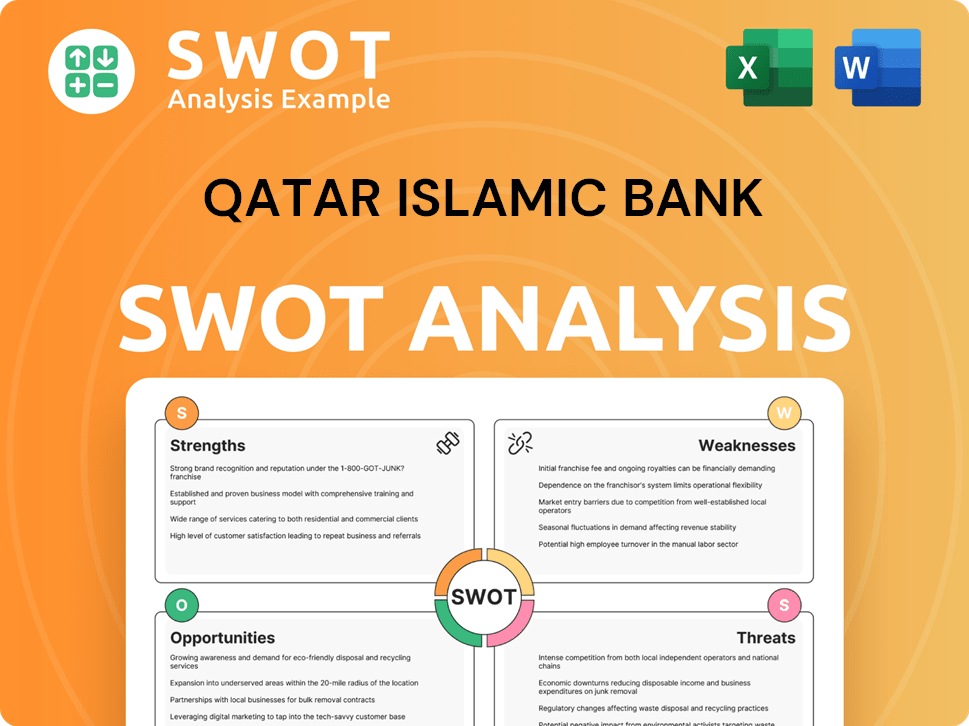
How Has Qatar Islamic Bank’s Ownership Changed Over Time?
The ownership structure of Qatar Islamic Bank (QIB) has evolved significantly since its establishment in 1982. Initially, QIB was not a publicly traded company. The shift to a publicly traded entity, with shares listed on the Qatar Stock Exchange (QSE), marked a key change. This transition broadened the ownership base, moving beyond the original founders to include a diverse group of investors.
The Initial Public Offering (IPO) was a crucial event in QIB's history, opening up opportunities for both institutional and individual investors to become shareholders. This change facilitated greater transparency and access to capital, supporting QIB's growth and expansion within the Islamic banking sector in Qatar. The IPO also aligned QIB with broader market practices, enhancing its governance and regulatory compliance.
| Event | Impact on Ownership | Year |
|---|---|---|
| Establishment of QIB | Private ownership | 1982 |
| Initial Public Offering (IPO) | Transition to public ownership, broadening shareholder base | Various |
| Market Fluctuations | Changes in shareholding percentages among major stakeholders | Ongoing |
As of early 2025, the major stakeholders in QIB primarily consist of prominent Qatari institutions, government-related entities, and public shareholders. The Qatar Investment Authority (QIA), Qatar's sovereign wealth fund, holds a significant indirect stake in many major Qatari companies, including financial institutions like QIB. While specific percentage holdings are subject to market changes and confidential disclosures, QIB's annual reports and filings detail the breakdown of major shareholders. Key shareholders typically include Qatar Holding LLC (linked to QIA), the General Retirement and Social Insurance Authority, and other large investment funds and high-net-worth individuals within Qatar. For more insights, check out the Target Market of Qatar Islamic Bank.
QIB's ownership structure includes both institutional and individual investors.
- Qatar Investment Authority (QIA) is a significant indirect stakeholder.
- Qatar Holding LLC, linked to QIA, is a major shareholder.
- The General Retirement and Social Insurance Authority is a key institutional investor.
- Other large investment funds and high-net-worth individuals also hold shares.
Qatar Islamic Bank PESTLE Analysis
- Covers All 6 PESTLE Categories
- No Research Needed – Save Hours of Work
- Built by Experts, Trusted by Consultants
- Instant Download, Ready to Use
- 100% Editable, Fully Customizable
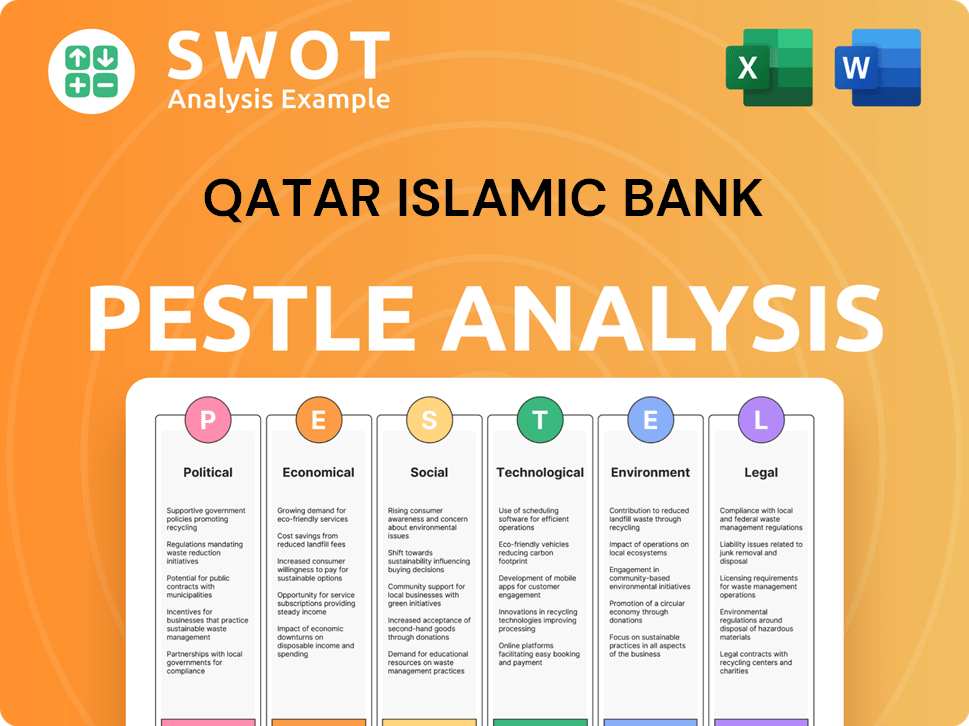
Who Sits on Qatar Islamic Bank’s Board?
The current Board of Directors of Qatar Islamic Bank (QIB) is pivotal in overseeing the bank's governance and strategic direction. As of early 2025, the board typically includes members representing major institutional shareholders and independent directors who offer external expertise. Representatives from entities like Qatar Holding LLC or other significant investment bodies often hold board seats, ensuring alignment between major ownership interests and the bank's strategic goals. The board's composition reflects the interests of QIB's primary shareholders, ensuring that key decisions are made with their perspectives in mind.
The board's structure is designed to ensure effective oversight and strategic guidance. The directors bring a wealth of experience in finance, banking, and related fields. Their diverse backgrounds contribute to robust decision-making processes, crucial for navigating the complexities of the financial market. The board's role includes setting strategic direction, overseeing risk management, and ensuring compliance with regulatory requirements. This structure helps maintain transparency and accountability within the bank.
| Board Member | Role | Affiliation |
|---|---|---|
| Sheikh Jassim bin Hamad bin Jassim bin Jaber Al Thani | Chairman | Qatar Holding LLC |
| Mr. Abdulla Mubarak Al-Khalifa | Managing Director | QIB |
| Mr. Hussain Ali Al-Abdulla | Director | Independent |
The voting structure at QIB generally follows a one-share-one-vote principle, common for publicly listed companies on the Qatar Stock Exchange. There are no publicly disclosed details suggesting any arrangements that would grant outsized control to specific individuals or entities beyond their proportional shareholding. The bank's governance adheres to the regulations of the Qatar Central Bank and the Qatar Financial Markets Authority, ensuring transparency and good governance practices. This structure supports fair representation and decision-making processes, reflecting the interests of all shareholders. For more insights, you might find the Competitors Landscape of Qatar Islamic Bank helpful.
Understanding QIB's ownership structure is crucial for investors and stakeholders. The board is composed of representatives from major shareholders and independent directors. This structure ensures that the bank's strategic direction aligns with shareholder interests and regulatory requirements.
- Major shareholders influence strategic decisions.
- Independent directors provide external expertise.
- Voting follows a one-share-one-vote principle.
- Governance is overseen by the Qatar Central Bank and the Qatar Financial Markets Authority.
Qatar Islamic Bank Business Model Canvas
- Complete 9-Block Business Model Canvas
- Effortlessly Communicate Your Business Strategy
- Investor-Ready BMC Format
- 100% Editable and Customizable
- Clear and Structured Layout
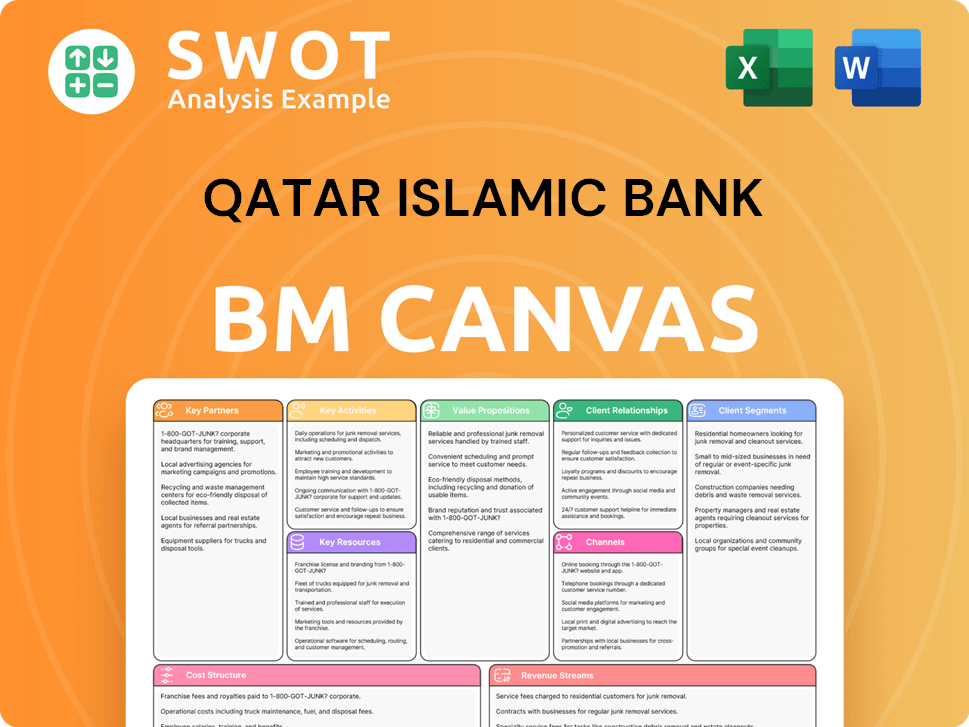
What Recent Changes Have Shaped Qatar Islamic Bank’s Ownership Landscape?
Over the past few years, the ownership structure of Qatar Islamic Bank (QIB) has remained relatively stable, reflecting its established position within the Islamic banking sector in Qatar. The focus has been on strategic initiatives and operational excellence rather than significant shifts in QIB ownership. Major shareholders, including large Qatari funds and government-related entities, continue to hold substantial stakes, indicating a long-term investment strategy in one of Qatar's key financial institutions. This stability is characteristic of many Qatar financial institutions.
There have been no major publicly announced share buybacks or secondary offerings that would drastically alter the QIB ownership. Leadership changes, such as appointments to the board of directors, occur periodically within the existing governance framework. The bank's focus remains on sustainable growth, enhancing shareholder value, and adapting to digital transformation within the Islamic finance sector. For more insights, you can explore the Growth Strategy of Qatar Islamic Bank.
| Aspect | Details | Recent Trends |
|---|---|---|
| QIB Ownership | Publicly listed company | Stable, with key Qatari institutional investors. |
| Major Shareholders | Large Qatari funds, government-related entities | Consistent significant stakes. |
| Share Buybacks/Offerings | None | No significant changes in ownership. |
The key executives at Qatar Islamic Bank, along with the board of directors, continue to oversee the bank's operations. The bank's headquarters are located in Qatar. The focus is on enhancing shareholder value through strategic initiatives. As of the latest available data, QIB's financial performance and ownership structure reflect a commitment to sustainable growth within the Islamic banking Qatar landscape. The services offered by Qatar Islamic Bank cater to a wide range of customers. The annual report provides detailed ownership information.
The ownership structure of QIB has shown stability. This stability reflects a long-term investment strategy. Major Qatari funds and government-related entities remain key shareholders.
QIB's recent developments emphasize organic growth. Digital transformation and strengthening market position are priorities. The bank focuses on sustainable growth and operational excellence.
There have been no major share buybacks or offerings. Leadership changes occur within the existing framework. No dramatic shifts in QIB ownership have been observed recently.
The bank is publicly traded. The focus is on enhancing shareholder value. QIB continues to adapt to the Islamic finance sector.
Qatar Islamic Bank Porter's Five Forces Analysis
- Covers All 5 Competitive Forces in Detail
- Structured for Consultants, Students, and Founders
- 100% Editable in Microsoft Word & Excel
- Instant Digital Download – Use Immediately
- Compatible with Mac & PC – Fully Unlocked
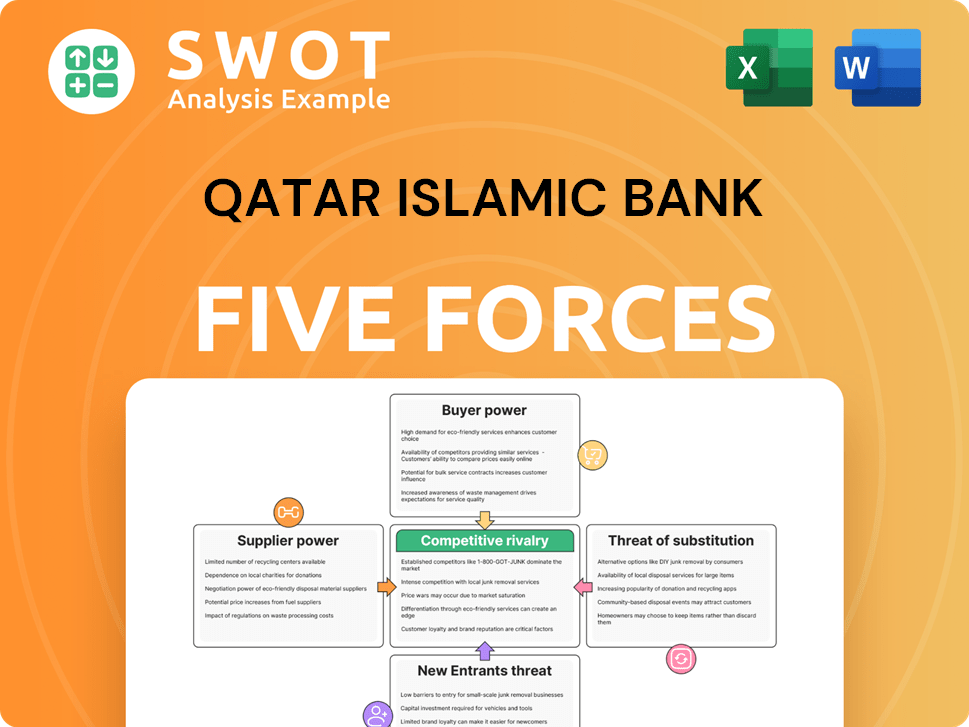
Related Blogs
- What are Mission Vision & Core Values of Qatar Islamic Bank Company?
- What is Competitive Landscape of Qatar Islamic Bank Company?
- What is Growth Strategy and Future Prospects of Qatar Islamic Bank Company?
- How Does Qatar Islamic Bank Company Work?
- What is Sales and Marketing Strategy of Qatar Islamic Bank Company?
- What is Brief History of Qatar Islamic Bank Company?
- What is Customer Demographics and Target Market of Qatar Islamic Bank Company?
Disclaimer
All information, articles, and product details provided on this website are for general informational and educational purposes only. We do not claim any ownership over, nor do we intend to infringe upon, any trademarks, copyrights, logos, brand names, or other intellectual property mentioned or depicted on this site. Such intellectual property remains the property of its respective owners, and any references here are made solely for identification or informational purposes, without implying any affiliation, endorsement, or partnership.
We make no representations or warranties, express or implied, regarding the accuracy, completeness, or suitability of any content or products presented. Nothing on this website should be construed as legal, tax, investment, financial, medical, or other professional advice. In addition, no part of this site—including articles or product references—constitutes a solicitation, recommendation, endorsement, advertisement, or offer to buy or sell any securities, franchises, or other financial instruments, particularly in jurisdictions where such activity would be unlawful.
All content is of a general nature and may not address the specific circumstances of any individual or entity. It is not a substitute for professional advice or services. Any actions you take based on the information provided here are strictly at your own risk. You accept full responsibility for any decisions or outcomes arising from your use of this website and agree to release us from any liability in connection with your use of, or reliance upon, the content or products found herein.